This website is made possible by readers. I may earn a small commission when you buy through the links in this article at no extra cost to you. Learn more.
Details
| 100W Single-Port | 66W 3-Port | 108W 3-Port | |
| Price | $69.99 | $54.99 | $74.99 |
| Weight | 6.7 oz (189.9 g) | 4.1 oz (116.2 g) | 6.7 oz (189.9 g) |
| Dimensions | 2.75 x 2.37 x 1.2 in 6.98 x 6.01 x 3.05 cm | 2.8 x 1.5 x 1.2 in 7.11 x 3.81 x 3.05 cm | 3.58 x 1.88 x 1.25 in 9.09 x 4.77 x 3.17 cm |
| Ports | 1 | 3 | 3 |
| Purchase Link | Buy | Buy | Buy |
Overview
Satechi offers a variety of wall chargers, and in this review, I will be looking at three of them; the 108W 3-Port, 66W 3-Port, and 100W single-port versions. I didn't include the 20W or 30W dual-port versions since I intended these wall chargers to charge my laptop.
For ease of understanding, I will refer to the three chargers as the following in this review:
- 100W USB-C PD WALL CHARGER – 100W Single-Port Charger
- 66W USB-C 3-PORT GAN WALL CHARGER – 66W 3-Port Charger
- 108W USB-C 3-PORT GAN WALL CHARGER – 108W 3-Port Charger
As a digital nomad, I am always on the move. Even if not traveling, I always find myself restless if I stay home for too many days in a row. Whether it's exploring a new town or cafe-hopping, a wall charger is essential. While the new M1 MBPs can last almost an entire day, I always bring along a charger since being out of juice will jeopardize my job.
All this time, I've been somewhat satisfied with my RAVPOWER 61W Charger. However, the thing about having a compact digital nomad setup—the obsession to optimize it never stops.
My current setup is as follows.
- RAVPOWER 61W Charger
- Satechi USB-C 100W Cable
- Nitecore NB10000
- Satechi 10-Inch USB-C to Lightning Cable
- Apple Airpods Pro in the NOMAD Active Rugged Case
- All of the above is housed in the Aer Slim Pouch
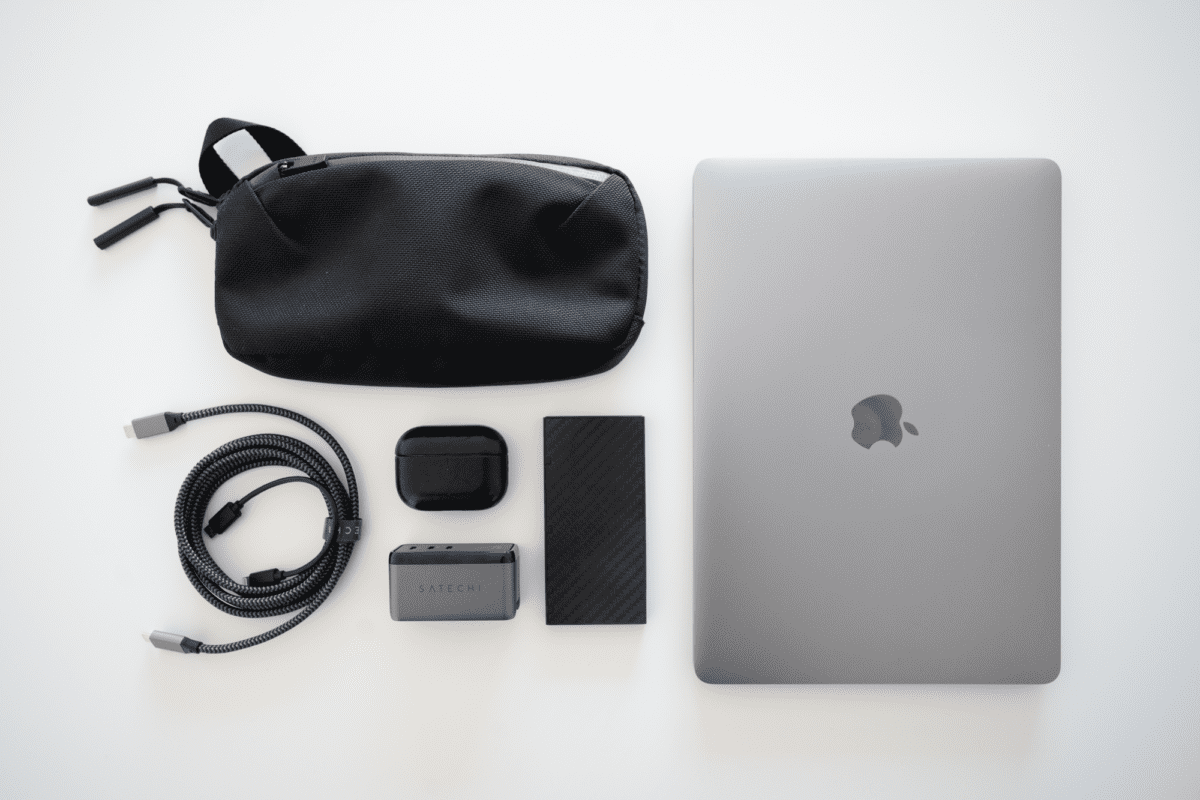
This is the setup I've been tweaking to a stage that I'm pretty comfortable with. Although when I travel, I do make a few adjustments, i.e., add a few cables and swap the Nitecore NB10000 with the Nitecore NB20000.
With so few elements, it's only natural for a gear addict like me to optimize what is possibly one of the most important elements in my kit. This is what spurred my deep dive into Satechi's wall charger.
How many ports do you really need?
The number of ports you need on a charger is a huge factor when choosing the right one. This largely depends on the number of devices you need to charge at the same time.
For a day out, I never find myself needing to charge anything more than my laptop. My Airpods Pro usually lasts the entire day. I charge my phone with the Nitecore NB10000 since I find myself using it even when charging, and I don't want to bring along a long lightning cable. On the rare occasion when my battery pack runs out of charge, I charge my phone via my laptop.
For travel, there are much more variables involved. The uncertainty of getting a power outlet forces me to charge every device I have when I can. While I've been making do with a single port for the last few years, three ports let me charge my laptop, phone, and mobile battery, all at once.
This used to be an ad.
But no one likes ads, so I got rid of them. If my articles helped you, I ask for your support so I can continue to provide unbiased reviews and recommendations. Every cent donated through Patreon will go into improving the quality of this site.
Ports with more ports sacrifice power output, price, weight, or all three. This is why Satechi, like most brands, offers these three options with differing power.
In the end, it depends on your needs, but personally, one port for a day out and three ports for travel is my sweet spot.
Style
It's hard to talk about Satechi's products without mentioning how great they look. Like Aer and their backpacks, Satechi puts a heavy focus on design. And it shows.
I've tested a few of Satechi's products, and one thing that impresses me with their products is how consistent the standard of design is. It's easy to see that Satechi's products are designed for the Apple aesthetic, with the color palette mimicking the exact tone of Apple's series of laptops.
The wall chargers are no different. The chargers are a mix of aluminum grey and black. It's also interesting to note that the grey on 100W Single-Port Charger is in a lighter tone than the other two.
The positions of the colors also differ between the single-port and 3-port versions. One the single-port version, the black face is on the pin side, while being on the port side on the 3-port version. Because of this, the power output, “GaN” print, and the port labels are much more subtle on the 3-port versions.
Another detail I noticed was that, on the 3-port chargers, the black port face has a plastic rim around it, while it looks to be a single piece on the single-port.
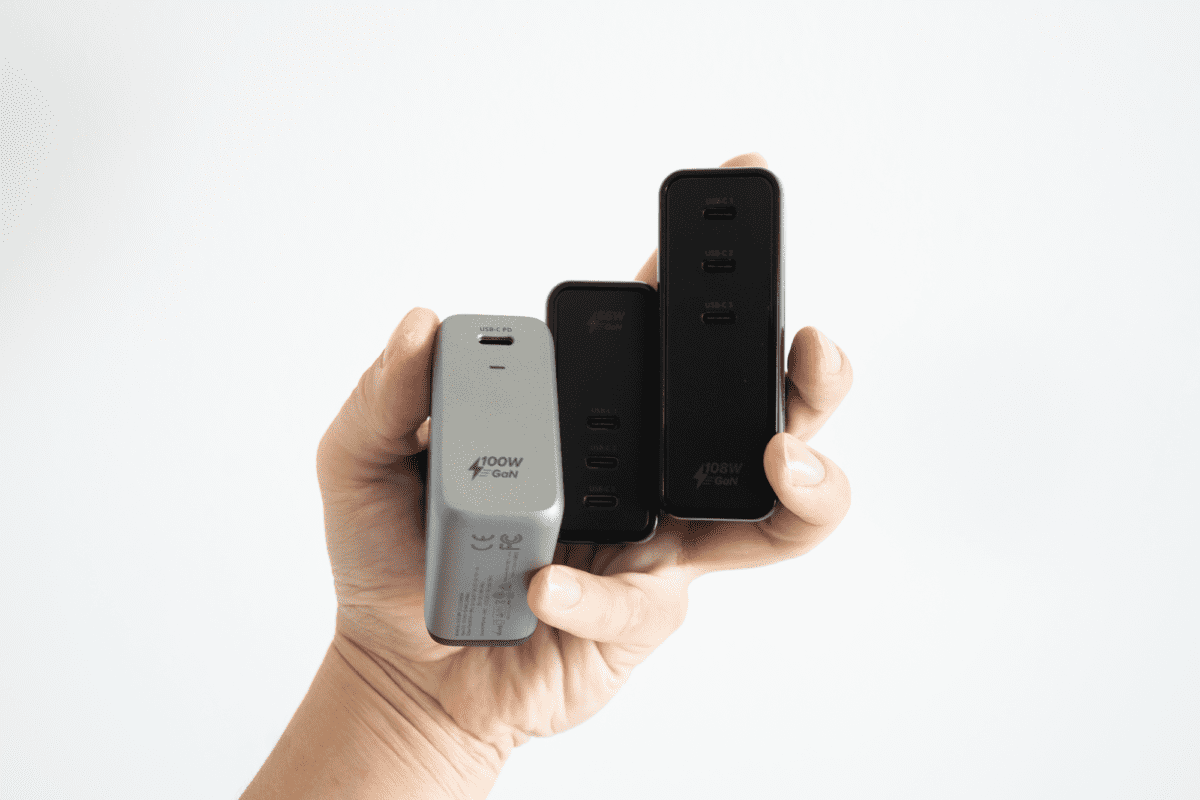
These accommodations were probably necessary for the assembly of the port side. But because of these details, the unibody look of the single-port charger looks a little better to me.
I designed a thing.

I found a 100 year old company that would create these heirloom quality canisters for me. They are handmade and will keep your tea leaves, coffee beans or anything that you need dry for years to come.
or read review
Compliance logos are required to be displayed on chargers. Satechi deliberately tries to keep these marks out of the way by having them on the bottom of the single-port charger and the back of the 3-port chargers. That way, you won't have to look at them in regular use.
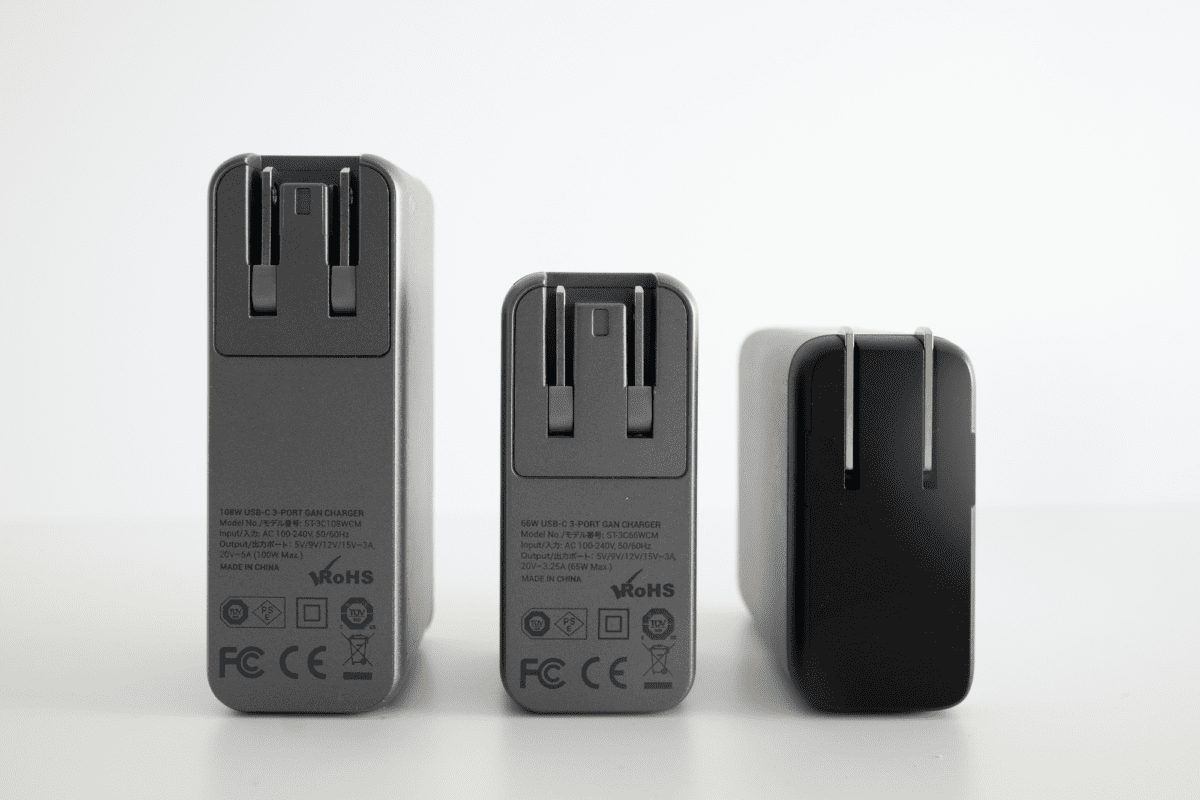
There are distinct differences between the single-port and 3-port versions. Even then, the design language that Satechi is known for permeates thoroughly throughout all of them. Most USB-C chargers on the market are starting to up their design game, but Satechi remains the top few and will likely keep its position for years to come.
Tech
After the number of ports, the next most important factor you need to consider is power output and technology.
Will Satechi's charger charge my laptop?
Unfortunately, charge speeds depend on a variety of factors. Without optimum charge speeds, your laptop could actually use up more power than it is being charged. This will happen especially for power users who perform intensive operations like playing triple-A games or video editing.
USB-C chargers come with a watt rating. This rating tells you the maximum output that you can charge this device with the charger. There are two conditions here—that is, you are using a cable that can transmit this amount of power and that your device can accept the charge.
As you can see, the maximum charging speed of your device will help you decide the amount of power you need. For example, the iPhone 13 Pro Max can be charged up to 27W.
There are also other factors to charge speed. For example, using a genuine 87W Apple charger, you should be able to get 86W of charge, but if you are charging through a USB hub like the Satechi Multiport Adapter, it will be reduced to 49W.
Given that Apple's 87W charge will juice up all models of MacBooks and MacBook Pros at full speed, it is safe to assume that Satechi's 108W 3-Port Charger and 100W Single-Port Charger will do the same.
As for the 66W charger, I'll say that it will be fine if you are doing nothing intensive. After all, I am charging my 16-inch MacBook Pro at 49W through the Satechi Multiport Adapter. The problem comes when you are running intensive games or performing heavy graphics-processing tasks. When I play Red Dead Redemption 2 on Boot Camp, my charge goes zero in a few hours.
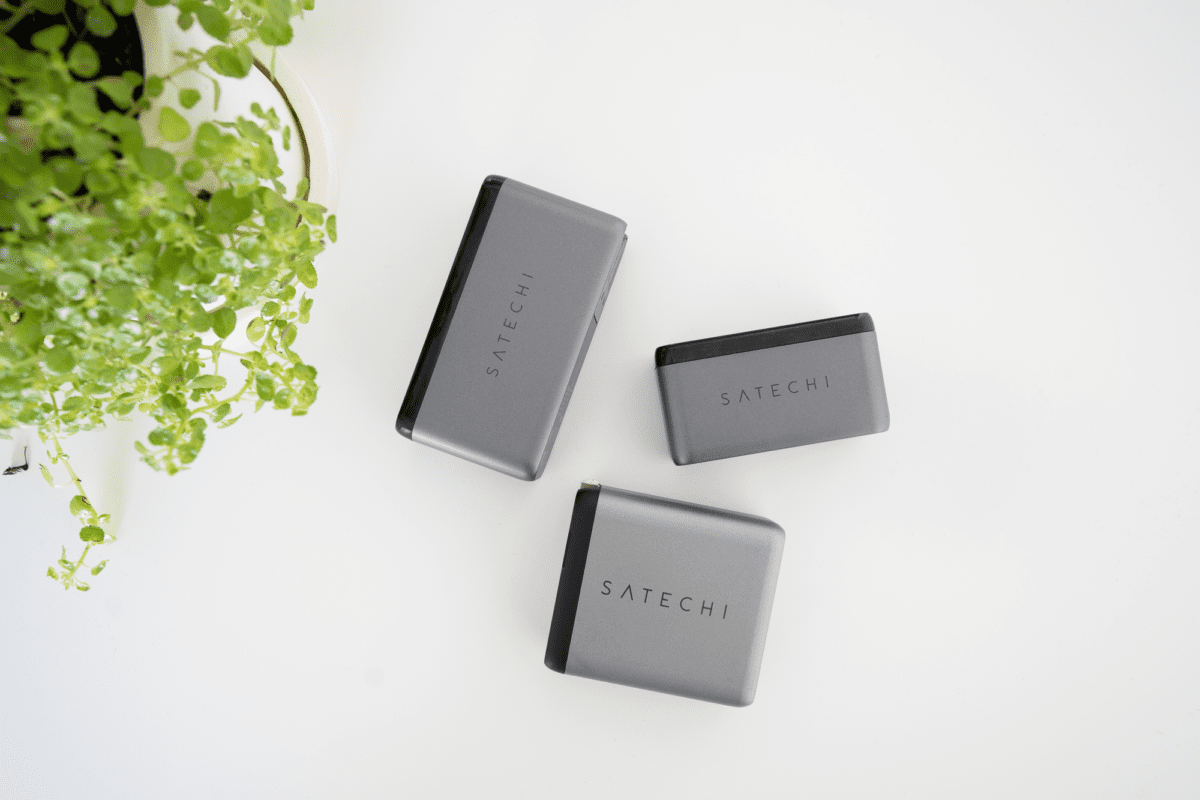
Unless you are a 3D modeler, pro gamer, or video editor, it's more than likely the 66W is more than enough for your needs. This is the one that I replaced my RAVPOWER 61W Charger with.
Of course, all of the above doesn't consider the situation where you are using multiple ports at once. The power will be further divided between the ports. Here are the exact charge speeds I got with my 13-Inch M1 MacBook Pro.
- 108W 3-Port Charger
- No other ports in use – 100W
- With a second port charging an iPhone) – 60W
- With a second port charging an iPhone and third port charging an AirPods) – 30W
- 66W 3-Port Charger
- No other ports in use – 60W
- With a second port charging an iPhone) – 30W
- With a second port charging an iPhone and third port charging an AirPods) – 30W
- 100W Single-Port Charger – 100W
As you can see, the power is split evenly on the 108 3-Port with all three ports in use, while on the 66W 3-Port Charger, it looks like one port gets a minimum of 30W while the other two share the remaining power.
GaN, PD, QC, what do all these abbreviations mean?!
When shopping for USB-C chargers, you'll encounter these terms, often baked into the product name itself. These are key criteria that don't escape the eagle eye of the seasoned USB-C aficionado.
Satechi, themselves, have GaN and PD specified proudly on their product page.
First of all, GaN and PD don't exactly belong to the same category.
GaN stands for Gallium Nitride, which is the material used that increases the efficiency of a charger. GaN replaces silicon, which has served us valiantly for the past decade but has since become the bottleneck that prevents chargers from getting any more compact.
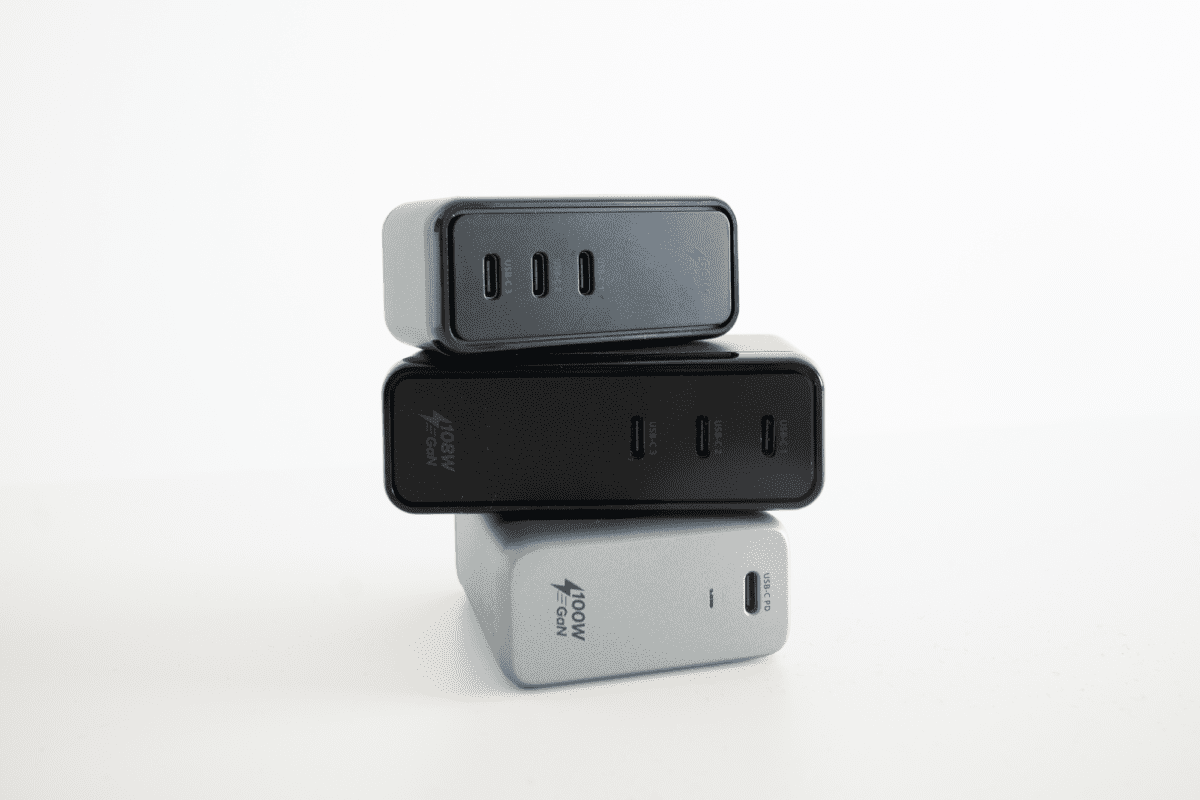
GaN is a crystal-like material that can conduct higher voltages at faster speeds and produce less heat. Simply put, GaN is the latest technology and is what you should be looking for in your next charger.
PD is a different thing and stands for Power Delivery, a charging standard that allows a charger to charge a wide array of devices. PD offers a couple of advantages. The most important one is the increased power output. Previously, each device would have its own adapters to prevent over or under-charging. PD chargers can negotiate with the recipient device to deliver the optimum amount of power, up to 100W.
The other advantage that's not really valid in this case is two-way power direction, which means that a PD-enabled device can take and give power through the same port. This is more applicable in something like the Nitecore NB10000, which has a port that allows power input and output.
Usage (& Comparison)
The size and weight of your charger are important if you are trying to shave off the extra weight from your pack. Every pound counts, and you can certainly feel that extra weight if you walk around the entire day.
Here is how the three compare:
| 100W Single-Port | 66W 3-Port | 108W 3-Port | |
| Price | $69.99 | $54.99 | $74.99 |
| Weight | 6.7 oz (189.9 g) | 4.1 oz (116.2 g) | 6.7 oz (189.9 g) |
| Dimensions | 2.75 x 2.37 x 1.2 in 6.98 x 6.01 x 3.05 cm | 2.8 x 1.5 x 1.2 in 7.11 x 3.81 x 3.05 cm | 3.58 x 1.88 x 1.25 in 9.09 x 4.77 x 3.17 cm |
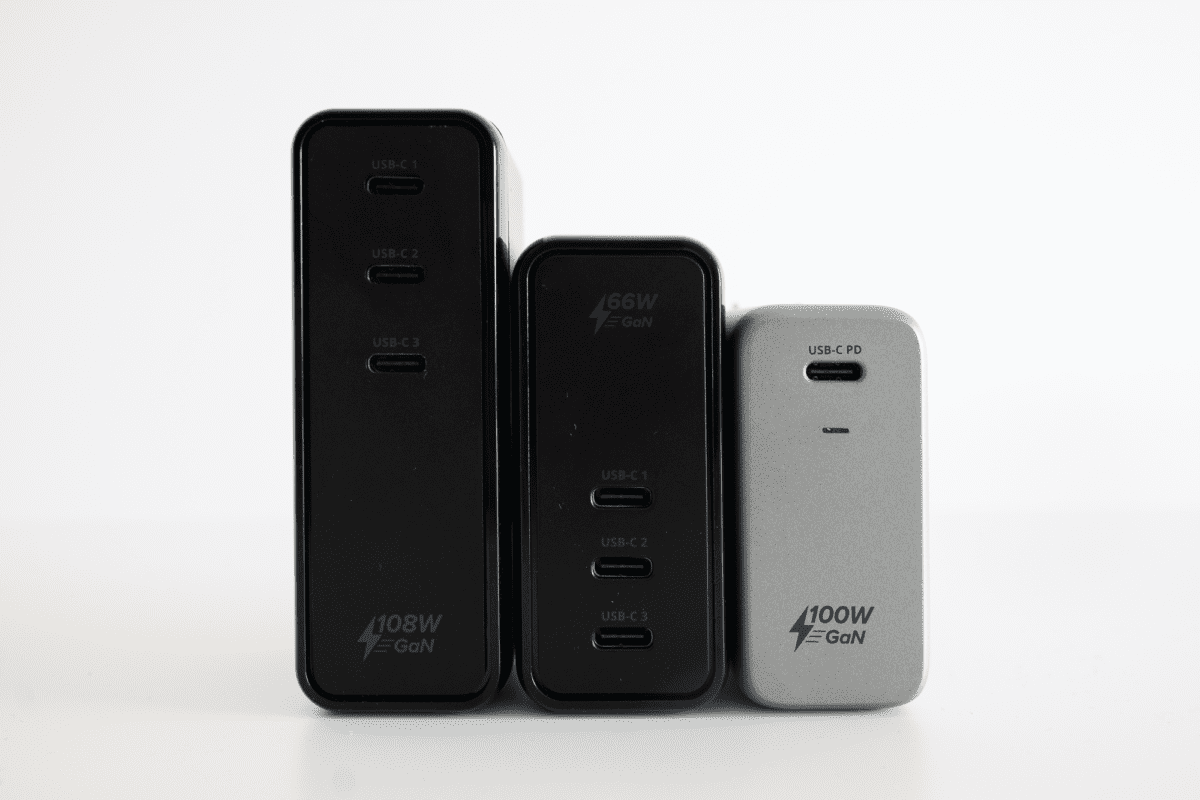
Even though the tech specs list the 100W Single-Port and the 66W 3-Port chargers as having the same width, I find that the 66W 3-Port Charger is slightly thicker than the 100W Single-Port Charger.
All three chargers are very compact, but the longish shape of the 108W 3-Port does make it a little less versatile when fitting into slots within organizational pouches.
And, of course, wall chargers like this will encroach into the space of the above socket, at least for the sockets in Japan.

Each comes with pins that can be folded in with a satisfying snap, almost a given with chargers designed for travel. The folding mechanism feels very solid. It is interesting to note that the folding feels more rigid and secure on the 3-port chargers compared to the single-port ones.
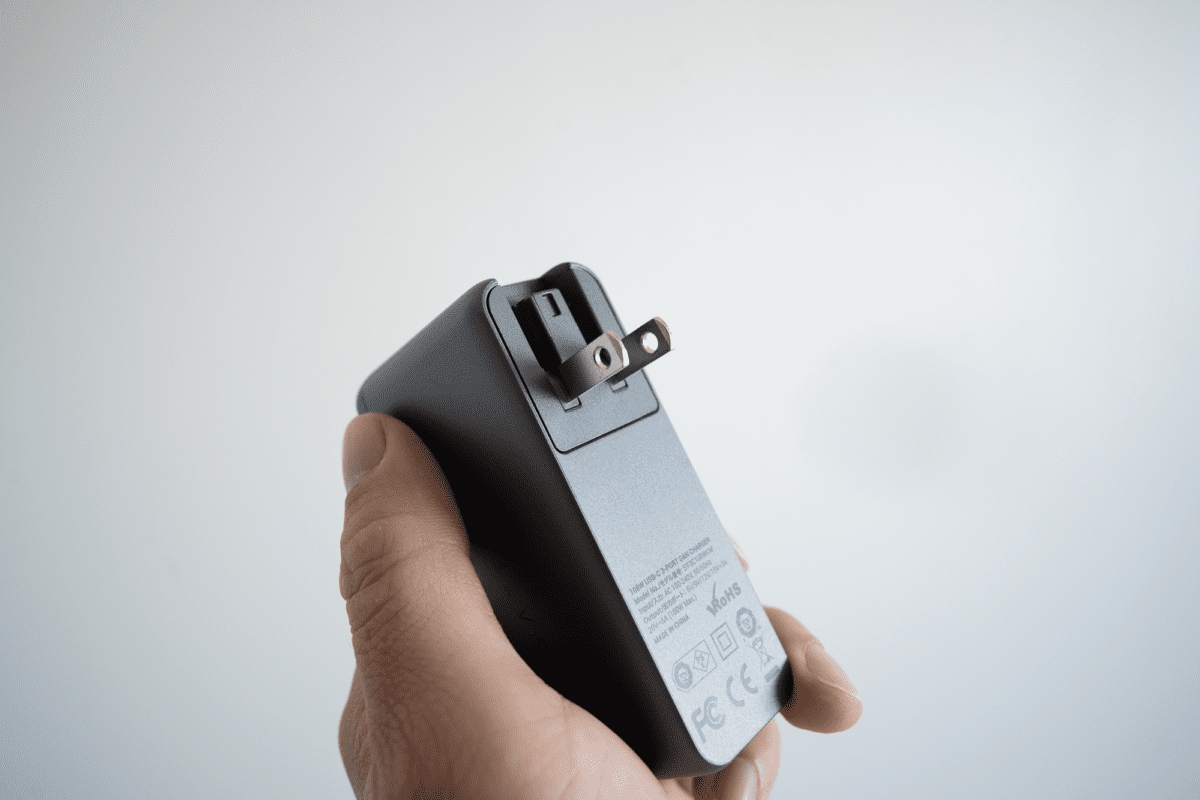
Each of the chargers comes with a single light indicator. It's white on the 3-Port versions and blue on the single-port version. In the 3-Port versions, the light appears along the rim on the top, which can be hard to notice.
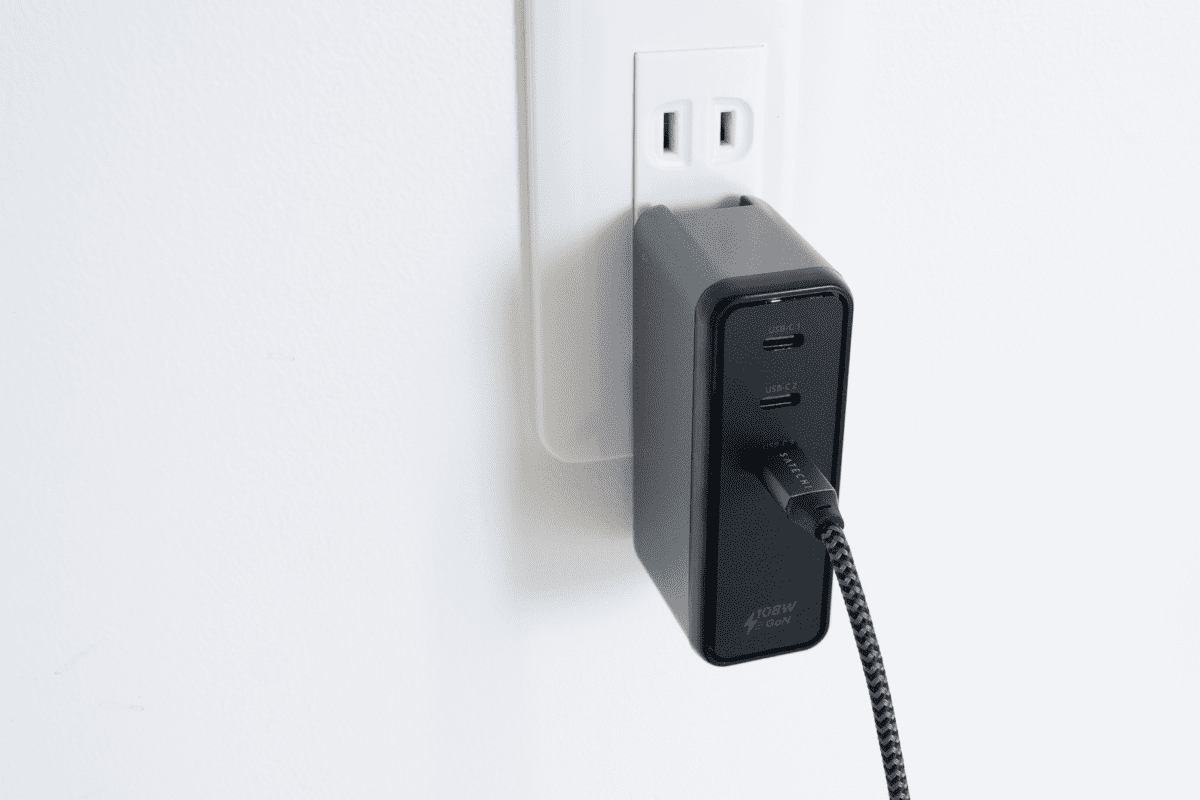
Some chargers have ports that stop working after extended periods of use. I will be updating this article if something happens.
Update: 6 Months Later
I was using the charger at a cafe one day and noticed that, while my laptop was charging through a port, my phone wasn't charging. I swap the ports around and it worked; both my phone and laptop were charging.
It seems that certain combinations or orders in which you charge your device might mess with the power output.
I used the 100W charger to charge my laptop from 0% to a full charge and the charger was searing hot after I removed it from the socket. It's so hot that I couldn't hold on to it for more than a few seconds.
Satechi 66W 3-Port Charger vs NOMAD 65W Power Adapter
The Satechi 66W 3-Port Charger has been my go-to charger for the past year and it is worth doing a comparison with my newest addition, the NOMAD 65W Power Adapter. At a glance:
| NOMAD 65W Power Adapter | Satechi 66W 3-Port Charger | Difference | |
| Price | $69.95 | $54.99 | The NOMAD adapter costs more by $14.96. |
| Weight | 4.06 oz (115 g) | 4.1 oz (116.2 g) | Both are practically the same weight. |
| Dimensions (prongs closed) | 2.17 x 2.07 x 1.33 inches 55 x 52.5 x 33.8 mm | 2.8 x 1.5 x 1.2 inches 71.1 x 38.1 x 30.5 mm | Both have almost the same size, just different shapes; The NOMAD adapter is square, while the Satechi charger is a rectangle. |
| Speed | 65W 45W/20W | 65W 30W/30W or 45W/20W 30W/18W/18W | The NOMAD adapter is less flexible in speed distribution. |
| Number of Ports | 2 | 3 | The NOMAD adapter has one less port. |
On paper, the Satechi 66W 3-Port Charger is the winner.
The NOMAD 65W Power Adapter does look a little sleeker and “unibody”, compared to the Satechi 66W 3-Port Charger with its glossy plastic-looking trim. The prongs of the Satechi 66W 3-Port Charger, when closed, do not stick out like the NOMAD 65W Power Adapter.
Despite the clear differences in specs, I find myself strangely drawn to the NOMAD 65W Power Adapter. I will be using it for the next couple of months and reevaluate how I feel about it.
Conclusion
These are fantastic-looking chargers that should be considered by anyone looking to upgrade their charging game. If you go for the 100W Single-Port or 108 3-Port chargers, you can charge any Apple device at full speed.
Satechi's chargers are not cheap, but I'd argue they are worth it if you look for that end-game charger to complete your arsenal.
Additional Images

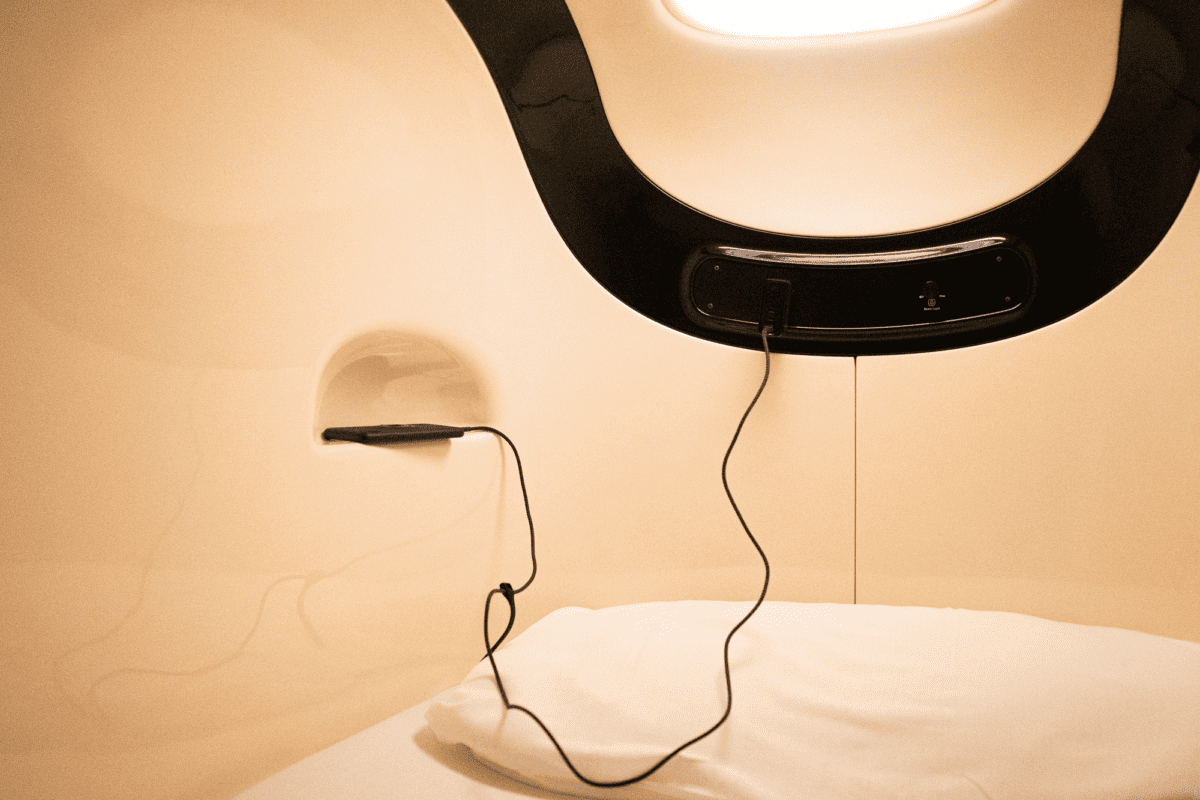
Like this review? See all of my in-depth reviews.
Also, consider supporting me by being a Patreon. Every cent given will go back into improving the content of this website.